The Fender Jazzmaster is an electric guitar designed as an upmarket sibling to the Fender Stratocaster. First introduced at the 1958 NAMM Show, it was initially marketed at jazz guitarists, but found favor among surf rock guitarists in the early 1960s. It is frequently confused with the similar looking albeit tonally different Jaguar.
Features
The contoured "offset-waist" body was designed for comfort while playing the guitar in a seated position, as many jazz and blues artists prefer to do. A full 25½” scale length, lead and rhythm circuit switching with independent volume and tone controls, and a floating tremolo with tremolo lock, were other keys to the Jazzmaster's character. The tremolo lock can be manually activated to keep the entire guitar from going out of tune if one string breaks. The Jazzmaster also had an extra-long tremolo arm.
The body is larger than that of other Fender guitars, requiring a more spacious guitar case. The Jazzmaster had unique wide, white "soapbar" pickups that were unlike any other single coil. Jazzmaster pickups are often confused with Gibson's P-90 pickups. Although their construction is similar, it is not identical. The coil is wound flat and wide, in contrast to Fender's usual tall and thin coils. This gives them a warmer tone without losing their single coil clarity. The Jazzmaster has a mellower, jazzier tone than the Strat, although it was not widely embraced by jazz musicians. Instead, rock guitarists adopted it for surf rock. The Ventures and The Fireballs were prominent Jazzmaster users.
Fender recognized the need for a purpose-designed surf-guitar, and introduced the 24" scale Fender Jaguar, with a shorter scale, built-in mute, chrome decorations and more Strat-like pickups. The main aspect that deterred jazz players was the Jazzmaster's tendency to produce feedback, especially if the body cavity were left without magnetic shielding. More experimentally-minded rock artists like Sonic Youth and My Bloody Valentine later embraced this as a new way to color their music. The Jazzmaster was also the first Fender guitar carrying a separate rosewood fingerboard with clay dot position inlays glued into a two-piece maple neck and a four-ply brown tortoise shell pickguard, although from 1958 to mid 1959 they came with a one-ply gold anodized pickguard.
Some early pre-production/prototype examples came with a one-piece maple neck, a rubber fingerboard and/or a black painted aluminum pickguard. Rosewood became a standard fretboard material on other Fender models around 1959. Binding was added to the Jazzmaster fretboard in 1965, and in 1966 the dot markings were replaced by pearloid blocks. An optional maple fingerboard with black binding and block inlays was briefly offered in the mid-1970s. Jazzmaster bodies have been constructed from ash, alder, and basswood over the years.
The Jazzmaster was officially discontinued in 1980. The Jazzmaster was re-introduced in 1984 as a 1962 reissue model from Fender's Japanese factory. The American Vintage Series version was introduced in 1999. In 2007 Fender announced plans for a 'thin skin' Jazzmaster reissue with vintage nitrocellulose finish. The finish on the AVRI series is also nitro, but a 'thin skin' has a thinner nitro coat than usual.
One of Jazzmaster's characteristics is its string resonance, appearing at several fret positions.
Influence
Fender intended the Jazzmaster to represent a solid body alternative to the hollow body archtop guitars that were then ubiquitous among Jazz guitarists. As the Telecaster and Stratocaster had done in other popular musical genres, Fender hoped to initiate a revolution in Jazz guitar, at the expense of their arch-rival Gibson. While the Jazzmaster never caught on among its intended audience, the Telecaster is now adopted by notable Jazz guitarists, such as Bill Frisell, as an alternative to the traditional fully hollow "Jazz boxes" of yore.
Jazzmasters were most successful in the burgeoning California-based surf music and instrumental rock scene of the late 1950s and early 1960s. Fender headquarters was located in Southern California, and Leo Fender himself actively solicited local players' input and guidance in designing the Jazzmaster's followup, the Jaguar.
Jazzmasters, along with Jaguars and their imitators, fell out of fashion among players during the 1970s largely due to their "old-fashioned" appearance and sonic characteristics. The 70s rock sound meant "fat" humbucker tone and lots of sustain, so guitarists gravitated toward the Gibson Les Paul and its copies. The Jazzmaster's short sustain and warm piano-like tone was not favored. Fender continued to offer the Jazzmaster as part of its product line until 1980, however many collectors believe actual production ceased around 1976, with guitars sold after that period representing unsold inventory. Due to the unwanted, pawn-shop status of the guitars, young musicians were able to purchase the instruments very cheaply, obtaining the high quality guitars for little money.
Just as Fender discontinued the Jazzmaster, Tom Verlaine of Television and Elvis Costello started giving the guitar a cult following. Thus, they were later embraced by the American indie rock scene. Sonic Youth are notorious for the hoard of Jazzmasters they acquired starting around 1985 while the guitars were still affordable, and for their unique customization jobs (e.g. Lee Ranaldo's "Jazzblaster" with Fender Wide Range pickups). Sonic Youth were also famous for playing on the strings below the tailed bridge (near the tailpiece) to get church-bell-like tones; this is sometimes referred to as 3rd bridge technique. Other bands, such as Yes picked behind the nut to achieve similar sounds (on other guitar models), but in a Guitar World interview, Sonic Youth rejected this practice as "art rock". Ranaldo even has a pickup mounted behind the bridge on one of his guitars. With the increasing visibility of old Jazzmasters, and the prices of collectible Telecasters and Stratocasters soaring out of sight in the 1990s, Jazzmasters became highly valuable. Thefts of vintage Jazzmasters from Sonic Youth, Dinosaur Jr. and The Raveonettes in recent years illustrate this. Sonic Youth had nine Jazzmasters stolen from them in July 1999, along with dozens of other items.
Art Greenhaw of The Light Crust Doughboys uses a Jazzmaster on stage during his instrumental guitar segments with the band and in his guitar playing on Greenhaw Records' various Grammy-Winning and Grammy-Nominated albums in the gospel music field. Greg Camp (formerly of Smash Mouth) uses a Jazzmaster, while Robert Smith of The Cure used two Jazzmasters (which he named Black Torty & White Torty) for the majority of his band's early work. J Mascis of Dinosaur Jr. is a noted Jazzmaster devotee, and as of 2007 Fender produces a signature J Mascis Jazzmaster model. Mascis uses a Tune-o-matic bridge, however. The stock Jazzmaster continues to have a cultlike following in the shoegaze and dream pop community, which values the buzzing, otherworldly sounds made possible by Leo's bridge design. Kevin Shields of My Bloody Valentine uses them as his main guitars, and bandmate Bilinda Butcher used them in addition to her Jaguars. A closeup picture of a Jazzmaster is featured as the cover of their critically acclaimed album, Loveless (1991). One is also depicted on the cover of Band of Susans' Blessing And Curse EP (1987), although the band is more noted for their use of G&L guitars. Ira Kaplan of Yo La Tengo favors a Jazzmaster as well as other vintage Fender guitars, often playing behind-the-back solos in concert. Nels Cline, solo artist and lead guitarist of Wilco since 2004, uses the Jazzmaster as his main guitar. Thom Yorke of Radiohead (on occasion) uses his vintage Jazzmasters for live performances and the studio recordings of "Airbag" and "Weird Fishes/Arpeggi". Steven Drozd of The Flaming Lips uses a '67 Jazzmaster. Stephen Malkmus, solo artist (formerly of the highly influential 90s indie rock group Pavement), has used his vintage Jazzmaster as a main guitar throughout his career. J Mascis, Nels Cline, Tom Verlaine, Thurston Moore and Lee Ranaldo (of Sonic Youth) all performed at the "Jazzmaster 50th Anniversary Concert" at the Knitting Factory in New York on September 12, 2008. Luther Perkins was one of the first Jazzmaster players, owning an early white version. Frank Zappa briefly owned a Jazzmaster very early in his career (prior to his joining The Mothers). John Lennon was photographed playing a white Jazzmaster during a Hamburg concert with The Beatles in 1966.
Imitations and reissues
There are a wide array of budget-priced overseas Jazzmaster imitations, particularly from the 1960s and '70s. Dillion, Yamaha, Framus, Teisco, Aria, Jansen, Harmony, National and Demel are some of the companies who indulged, mainly to capitalize on the surf rock sound of the 1960s. Many of the modern copies replace the Jazzmaster's bridge and tremolo setup with a Stratocaster-derived assembly, altering the character of the guitar considerably but making it more palatable to players used to the Strat. The vintage copies are rising in price, with guitars costing under $100 as little as 5 years ago now selling for as much as $600. Fender eventually got the offset-waist body shape patented, putting an end to the 'copy era'.
Fender's Japanese facility is noted for the high quality of its offset-waist guitars. These MIJ or CIJ (Made or Crafted In Japan) reissues have been sporadically available outside Japan since the late 1980s, either from Japanese dealers willing to ship overseas, or from US dealers who have imported them. However, these Japanese-made Jazzmasters, except for those with JV-prefix serial numbers, are often criticized for essentially having narrow Stratocaster pickups inside the wide soapbar Jazzmaster housings, thus giving the guitar a Strat/Jaguar "honk" rather than the classic, mellow Jazzmaster sound. Since 1996, its Squier offshoot has manufactured a budget version called the Jagmaster, though its humbucker pickups and Stratocaster-style bridge give it a much different, "hard rock" sound.
In May 2008 Fender introduced the Classic Player Series Jazzmaster, which is made in Mexico. Fender have made numerous changes to the original design, replacing the bridge with a Tune-o-matic type, giving it a 9.5" fretboard radius, moving the tremolo plate closer to the bridge and installing special designed P-90-type high-output single-coil pickups with a bar magnet at the base instead of the more Strat-like magnetized polepieces of the original pickups.
September 2010 saw the introduction of the Mexican-made Black Top Jazzmaster HS. This guitar sports a Duncan Designed single-coil Jazzmaster neck pickup and a hot vintage alnico humbucking bridge pickup, with other distinctive touches including skirted black amp knobs, a Jazzmaster tremolo tailpiece and a three-way toggle switch. Other features include an alder body, maple neck with 9.5”-radius rosewood fretboard, 21 medium-jumbo frets, gloss polyester finish and chrome hardware.
Signature editions
In July 2007, Fender released the J Mascis signature Jazzmaster, in honour of the Dinosaur Jr frontman. This model is much the same as previous Jazzmaster models aside from its Adjust-o-matic bridge (the Fender equivalent of the Gibson Tune-o-matic bridge), and its unusual purple sparkle finish. It is currently the only model of Jazzmaster in production with a matching headstock. In the past, a Nokie Edwards (of The Ventures) signature model was produced in Japan, without rhythm circuit.
April 2008 saw the introduction of the Elvis Costello Jazzmaster, the second signature Jazzmaster model made at the Corona facility - a faithful replication of Elvis Costello's 1960s Jazzmaster used during his 1977 debut album, My Aim is True. This signature Jazzmaster guitar features a solid walnut-stain finished alder body and a modified tremolo bridge for Costello's trademark "spy movie" sound. The Elvis Costello signature model has a natural brown finish and was released in 2008.
In June 2009, Fender announced Lee Ranaldo and Thurston Moore signature Jazzmasters, in honour of the guitarists of Sonic Youth. These models were released on July 1, 2009. Both editions are stripped down to have only one volume knob and a pickup switch that goes side to side and have a black headstock. The difference lies in the pickup, bridge, colour, and the relative placement of the volume knob to the jack input. Ranaldo's instrument has a Sapphire Blue finish and features dual Fender Wide Range humbucking pickups that are re-spec'd to Ranaldo's specifications and a Mustang bridge. Moore's version features a Forest Green finish, a pair of Seymour Duncan Antiquity II Jazzmaster single-coil pickups and a Tune-o-matic bridge. Users include Alex Turner of the Arctic Monkeys.
Colors
The vintage Jazzmasters (Original series) were produced in the following colors:
3-Color Sunburst as standard
Additionally, but NOT limited to the following:
Olympic White
Lake Placid Blue
Candy Apple Red
Black (post CBS)
semi-transparent blonde
Vintage Jazzmasters have been seen in most of the common Fender Custom Colors of the era, and as Fender would sometimes paint guitars in any shade the owner requested, one cannot list the full range of colors made.
The American Vintage Re-Issue (AVRI) Jazzmaster was produced in the following colors:
3-Color Sunburst
Olympic White
Black
Ocean Turquoise
Surf Green
Ice Blue Metallic
Their pickguards come in Mint Green or Brown Shell colors. Jazzmasters featured bound necks with block pearloid inlays from 1966 until the end of their original run in 1977; the headstocks were also larger ("CBS-style") in this era.They have featured matching headstocks (headstocks painted the same color as the body) at several points throughout the guitar's history. Matched-headstock versions generally fetch a higher price and are currently not in production, except for the special J. Mascis edition.
Colors of the signature editions:
J. Mascis - Purple sparkle
Elvis Costello - Natural Brown
Lee Ranaldo - Transparent Blue
Thurston Moore - Transparent Green.
Lee Ranaldo Jazzmaster
Series : Artist
Model : 0115100727
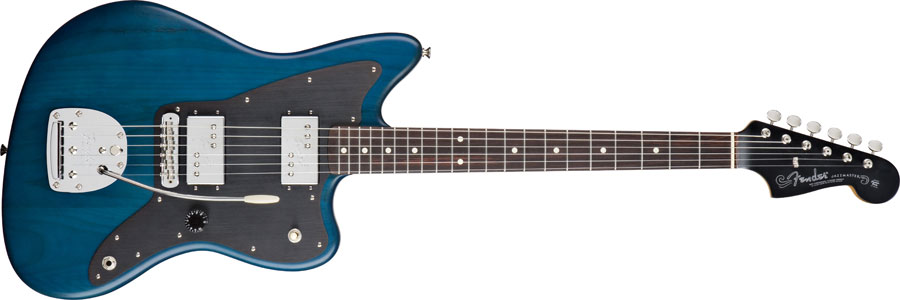
Thurston Moore Jazzmaster
Series : Artist
Model : 0115200750
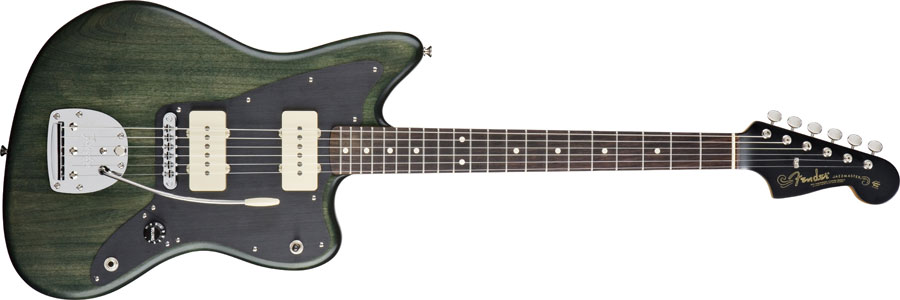
American Vintage '62 Jazzmaster
Series : American Vintage
Model : 0100800806
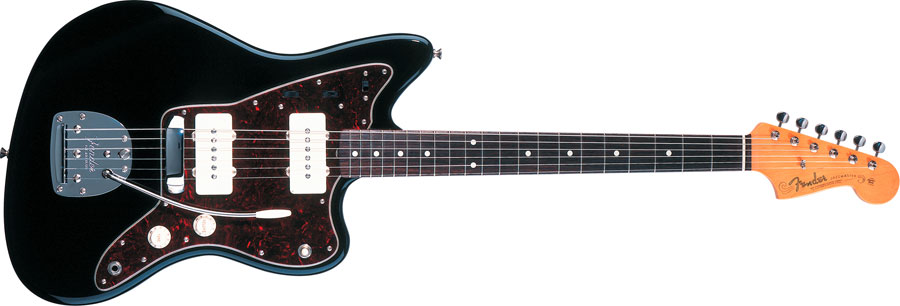
Classic Player Jazzmaster Special
Series : Classic Player
Model : 0141600306
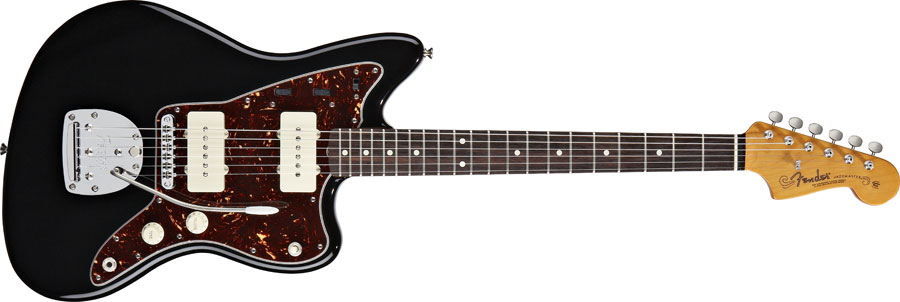
Blacktop™ Jazzmaster® HS
Series : Blacktop™
Model : 0148400500
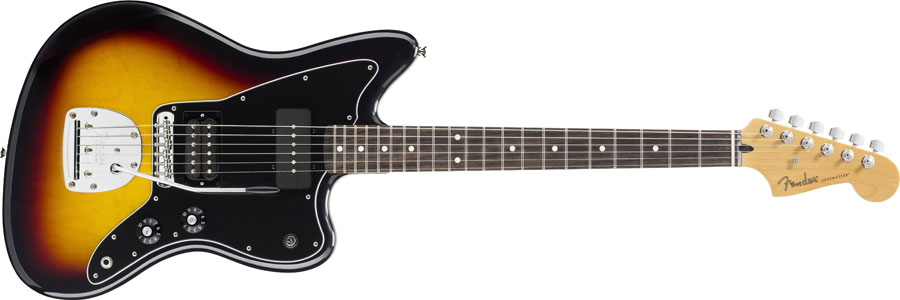
Features
The contoured "offset-waist" body was designed for comfort while playing the guitar in a seated position, as many jazz and blues artists prefer to do. A full 25½” scale length, lead and rhythm circuit switching with independent volume and tone controls, and a floating tremolo with tremolo lock, were other keys to the Jazzmaster's character. The tremolo lock can be manually activated to keep the entire guitar from going out of tune if one string breaks. The Jazzmaster also had an extra-long tremolo arm.
The body is larger than that of other Fender guitars, requiring a more spacious guitar case. The Jazzmaster had unique wide, white "soapbar" pickups that were unlike any other single coil. Jazzmaster pickups are often confused with Gibson's P-90 pickups. Although their construction is similar, it is not identical. The coil is wound flat and wide, in contrast to Fender's usual tall and thin coils. This gives them a warmer tone without losing their single coil clarity. The Jazzmaster has a mellower, jazzier tone than the Strat, although it was not widely embraced by jazz musicians. Instead, rock guitarists adopted it for surf rock. The Ventures and The Fireballs were prominent Jazzmaster users.
Fender recognized the need for a purpose-designed surf-guitar, and introduced the 24" scale Fender Jaguar, with a shorter scale, built-in mute, chrome decorations and more Strat-like pickups. The main aspect that deterred jazz players was the Jazzmaster's tendency to produce feedback, especially if the body cavity were left without magnetic shielding. More experimentally-minded rock artists like Sonic Youth and My Bloody Valentine later embraced this as a new way to color their music. The Jazzmaster was also the first Fender guitar carrying a separate rosewood fingerboard with clay dot position inlays glued into a two-piece maple neck and a four-ply brown tortoise shell pickguard, although from 1958 to mid 1959 they came with a one-ply gold anodized pickguard.
Some early pre-production/prototype examples came with a one-piece maple neck, a rubber fingerboard and/or a black painted aluminum pickguard. Rosewood became a standard fretboard material on other Fender models around 1959. Binding was added to the Jazzmaster fretboard in 1965, and in 1966 the dot markings were replaced by pearloid blocks. An optional maple fingerboard with black binding and block inlays was briefly offered in the mid-1970s. Jazzmaster bodies have been constructed from ash, alder, and basswood over the years.
The Jazzmaster was officially discontinued in 1980. The Jazzmaster was re-introduced in 1984 as a 1962 reissue model from Fender's Japanese factory. The American Vintage Series version was introduced in 1999. In 2007 Fender announced plans for a 'thin skin' Jazzmaster reissue with vintage nitrocellulose finish. The finish on the AVRI series is also nitro, but a 'thin skin' has a thinner nitro coat than usual.
One of Jazzmaster's characteristics is its string resonance, appearing at several fret positions.
Influence
Fender intended the Jazzmaster to represent a solid body alternative to the hollow body archtop guitars that were then ubiquitous among Jazz guitarists. As the Telecaster and Stratocaster had done in other popular musical genres, Fender hoped to initiate a revolution in Jazz guitar, at the expense of their arch-rival Gibson. While the Jazzmaster never caught on among its intended audience, the Telecaster is now adopted by notable Jazz guitarists, such as Bill Frisell, as an alternative to the traditional fully hollow "Jazz boxes" of yore.
Jazzmasters were most successful in the burgeoning California-based surf music and instrumental rock scene of the late 1950s and early 1960s. Fender headquarters was located in Southern California, and Leo Fender himself actively solicited local players' input and guidance in designing the Jazzmaster's followup, the Jaguar.
Jazzmasters, along with Jaguars and their imitators, fell out of fashion among players during the 1970s largely due to their "old-fashioned" appearance and sonic characteristics. The 70s rock sound meant "fat" humbucker tone and lots of sustain, so guitarists gravitated toward the Gibson Les Paul and its copies. The Jazzmaster's short sustain and warm piano-like tone was not favored. Fender continued to offer the Jazzmaster as part of its product line until 1980, however many collectors believe actual production ceased around 1976, with guitars sold after that period representing unsold inventory. Due to the unwanted, pawn-shop status of the guitars, young musicians were able to purchase the instruments very cheaply, obtaining the high quality guitars for little money.
Just as Fender discontinued the Jazzmaster, Tom Verlaine of Television and Elvis Costello started giving the guitar a cult following. Thus, they were later embraced by the American indie rock scene. Sonic Youth are notorious for the hoard of Jazzmasters they acquired starting around 1985 while the guitars were still affordable, and for their unique customization jobs (e.g. Lee Ranaldo's "Jazzblaster" with Fender Wide Range pickups). Sonic Youth were also famous for playing on the strings below the tailed bridge (near the tailpiece) to get church-bell-like tones; this is sometimes referred to as 3rd bridge technique. Other bands, such as Yes picked behind the nut to achieve similar sounds (on other guitar models), but in a Guitar World interview, Sonic Youth rejected this practice as "art rock". Ranaldo even has a pickup mounted behind the bridge on one of his guitars. With the increasing visibility of old Jazzmasters, and the prices of collectible Telecasters and Stratocasters soaring out of sight in the 1990s, Jazzmasters became highly valuable. Thefts of vintage Jazzmasters from Sonic Youth, Dinosaur Jr. and The Raveonettes in recent years illustrate this. Sonic Youth had nine Jazzmasters stolen from them in July 1999, along with dozens of other items.
Art Greenhaw of The Light Crust Doughboys uses a Jazzmaster on stage during his instrumental guitar segments with the band and in his guitar playing on Greenhaw Records' various Grammy-Winning and Grammy-Nominated albums in the gospel music field. Greg Camp (formerly of Smash Mouth) uses a Jazzmaster, while Robert Smith of The Cure used two Jazzmasters (which he named Black Torty & White Torty) for the majority of his band's early work. J Mascis of Dinosaur Jr. is a noted Jazzmaster devotee, and as of 2007 Fender produces a signature J Mascis Jazzmaster model. Mascis uses a Tune-o-matic bridge, however. The stock Jazzmaster continues to have a cultlike following in the shoegaze and dream pop community, which values the buzzing, otherworldly sounds made possible by Leo's bridge design. Kevin Shields of My Bloody Valentine uses them as his main guitars, and bandmate Bilinda Butcher used them in addition to her Jaguars. A closeup picture of a Jazzmaster is featured as the cover of their critically acclaimed album, Loveless (1991). One is also depicted on the cover of Band of Susans' Blessing And Curse EP (1987), although the band is more noted for their use of G&L guitars. Ira Kaplan of Yo La Tengo favors a Jazzmaster as well as other vintage Fender guitars, often playing behind-the-back solos in concert. Nels Cline, solo artist and lead guitarist of Wilco since 2004, uses the Jazzmaster as his main guitar. Thom Yorke of Radiohead (on occasion) uses his vintage Jazzmasters for live performances and the studio recordings of "Airbag" and "Weird Fishes/Arpeggi". Steven Drozd of The Flaming Lips uses a '67 Jazzmaster. Stephen Malkmus, solo artist (formerly of the highly influential 90s indie rock group Pavement), has used his vintage Jazzmaster as a main guitar throughout his career. J Mascis, Nels Cline, Tom Verlaine, Thurston Moore and Lee Ranaldo (of Sonic Youth) all performed at the "Jazzmaster 50th Anniversary Concert" at the Knitting Factory in New York on September 12, 2008. Luther Perkins was one of the first Jazzmaster players, owning an early white version. Frank Zappa briefly owned a Jazzmaster very early in his career (prior to his joining The Mothers). John Lennon was photographed playing a white Jazzmaster during a Hamburg concert with The Beatles in 1966.
Imitations and reissues
There are a wide array of budget-priced overseas Jazzmaster imitations, particularly from the 1960s and '70s. Dillion, Yamaha, Framus, Teisco, Aria, Jansen, Harmony, National and Demel are some of the companies who indulged, mainly to capitalize on the surf rock sound of the 1960s. Many of the modern copies replace the Jazzmaster's bridge and tremolo setup with a Stratocaster-derived assembly, altering the character of the guitar considerably but making it more palatable to players used to the Strat. The vintage copies are rising in price, with guitars costing under $100 as little as 5 years ago now selling for as much as $600. Fender eventually got the offset-waist body shape patented, putting an end to the 'copy era'.
Fender's Japanese facility is noted for the high quality of its offset-waist guitars. These MIJ or CIJ (Made or Crafted In Japan) reissues have been sporadically available outside Japan since the late 1980s, either from Japanese dealers willing to ship overseas, or from US dealers who have imported them. However, these Japanese-made Jazzmasters, except for those with JV-prefix serial numbers, are often criticized for essentially having narrow Stratocaster pickups inside the wide soapbar Jazzmaster housings, thus giving the guitar a Strat/Jaguar "honk" rather than the classic, mellow Jazzmaster sound. Since 1996, its Squier offshoot has manufactured a budget version called the Jagmaster, though its humbucker pickups and Stratocaster-style bridge give it a much different, "hard rock" sound.
In May 2008 Fender introduced the Classic Player Series Jazzmaster, which is made in Mexico. Fender have made numerous changes to the original design, replacing the bridge with a Tune-o-matic type, giving it a 9.5" fretboard radius, moving the tremolo plate closer to the bridge and installing special designed P-90-type high-output single-coil pickups with a bar magnet at the base instead of the more Strat-like magnetized polepieces of the original pickups.
September 2010 saw the introduction of the Mexican-made Black Top Jazzmaster HS. This guitar sports a Duncan Designed single-coil Jazzmaster neck pickup and a hot vintage alnico humbucking bridge pickup, with other distinctive touches including skirted black amp knobs, a Jazzmaster tremolo tailpiece and a three-way toggle switch. Other features include an alder body, maple neck with 9.5”-radius rosewood fretboard, 21 medium-jumbo frets, gloss polyester finish and chrome hardware.
Signature editions
In July 2007, Fender released the J Mascis signature Jazzmaster, in honour of the Dinosaur Jr frontman. This model is much the same as previous Jazzmaster models aside from its Adjust-o-matic bridge (the Fender equivalent of the Gibson Tune-o-matic bridge), and its unusual purple sparkle finish. It is currently the only model of Jazzmaster in production with a matching headstock. In the past, a Nokie Edwards (of The Ventures) signature model was produced in Japan, without rhythm circuit.
April 2008 saw the introduction of the Elvis Costello Jazzmaster, the second signature Jazzmaster model made at the Corona facility - a faithful replication of Elvis Costello's 1960s Jazzmaster used during his 1977 debut album, My Aim is True. This signature Jazzmaster guitar features a solid walnut-stain finished alder body and a modified tremolo bridge for Costello's trademark "spy movie" sound. The Elvis Costello signature model has a natural brown finish and was released in 2008.
In June 2009, Fender announced Lee Ranaldo and Thurston Moore signature Jazzmasters, in honour of the guitarists of Sonic Youth. These models were released on July 1, 2009. Both editions are stripped down to have only one volume knob and a pickup switch that goes side to side and have a black headstock. The difference lies in the pickup, bridge, colour, and the relative placement of the volume knob to the jack input. Ranaldo's instrument has a Sapphire Blue finish and features dual Fender Wide Range humbucking pickups that are re-spec'd to Ranaldo's specifications and a Mustang bridge. Moore's version features a Forest Green finish, a pair of Seymour Duncan Antiquity II Jazzmaster single-coil pickups and a Tune-o-matic bridge. Users include Alex Turner of the Arctic Monkeys.
Colors
The vintage Jazzmasters (Original series) were produced in the following colors:
3-Color Sunburst as standard
Additionally, but NOT limited to the following:
Olympic White
Lake Placid Blue
Candy Apple Red
Black (post CBS)
semi-transparent blonde
Vintage Jazzmasters have been seen in most of the common Fender Custom Colors of the era, and as Fender would sometimes paint guitars in any shade the owner requested, one cannot list the full range of colors made.
The American Vintage Re-Issue (AVRI) Jazzmaster was produced in the following colors:
3-Color Sunburst
Olympic White
Black
Ocean Turquoise
Surf Green
Ice Blue Metallic
Their pickguards come in Mint Green or Brown Shell colors. Jazzmasters featured bound necks with block pearloid inlays from 1966 until the end of their original run in 1977; the headstocks were also larger ("CBS-style") in this era.They have featured matching headstocks (headstocks painted the same color as the body) at several points throughout the guitar's history. Matched-headstock versions generally fetch a higher price and are currently not in production, except for the special J. Mascis edition.
Colors of the signature editions:
J. Mascis - Purple sparkle
Elvis Costello - Natural Brown
Lee Ranaldo - Transparent Blue
Thurston Moore - Transparent Green.
Lee Ranaldo Jazzmaster
Series : Artist
Model : 0115100727

Thurston Moore Jazzmaster
Series : Artist
Model : 0115200750

American Vintage '62 Jazzmaster
Series : American Vintage
Model : 0100800806

Classic Player Jazzmaster Special
Series : Classic Player
Model : 0141600306

Blacktop™ Jazzmaster® HS
Series : Blacktop™
Model : 0148400500


No comments:
Post a Comment